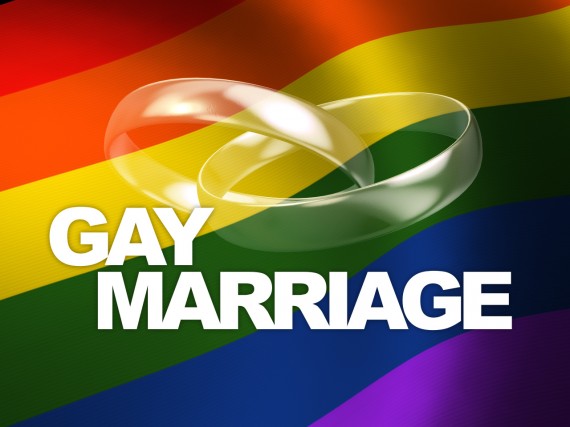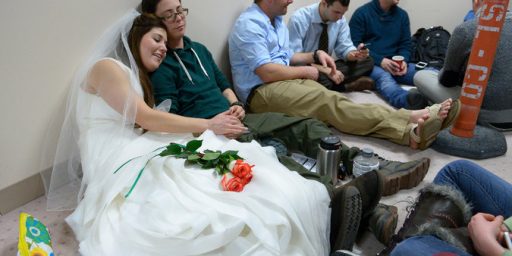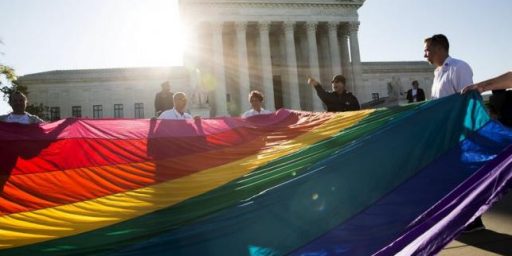Federal Judge Rules Ohio Must Recognize Out Of State Gay Marriages
A partial victory, but a victory nonetheless.
 A Federal Judge in Ohio has ordered the State of Ohio to recognize same-sex marriages performed in other states:
A Federal Judge in Ohio has ordered the State of Ohio to recognize same-sex marriages performed in other states:
U.S. District Court Judge Timothy Black has formally ruled that Ohio must recognize same-sex marriages performed legally in other states, but he put a hold on his order for the time being. “Ohio’s marriage recognition is facially unconstitutional and unenforceable under any circumstances,” Black said in a written order he announced verbally 10 days ago. “It is this court’s responsibility to give meaning and effect to the guarantees and of the U.S. Constitution and all American citizens and that responsibility is never more pressing than when the fundamental rights of some minority citizens are impacted by the legislative power of the majority.” The judge’s order does not directly impact Ohio’s 2004 constitutional ban on same-sex marriage, but the larger implications are unclear. Black said the “backward evolution in Ohio, from granting accurate birth certificates to adoptive same-sex parents and their children (during Gov. Ted Strickland’s term), to the current administration’s refusal to do so, is yet another manifestation of the irrational animus motivating defendants’ discriminatory treatment of lesbian and gay families.” “When a state effectively terminates the marriage of a same-sex couple married in another jurisdiction by refusing to recognize the marriage, that state unlawfully intrudes into the realm of private marital, family, and intimate relations specifically protected by the Supreme Court,” Black’s decision said. He added that children of same-sex couples “cannot be denied the right to two legal parents, reflected on their birth certificates and given legal respect, without a sufficient justification. No such justification exists.”
Lyle Denniston summarizes the Judge’s ruling:
The judge said that the record made before him in the case of Henry v. Himes was “staggeringly devoid of any legitimate justification” for Ohio’s “arbitrary discrimination on the basis of sexual orientation.” So he struck down the ban on recognizing legally valid marriages, saying it could not be enforced “under any circumstances.” Finding that the issue of same-sex marriage implicated “the fundamental rights of some minority of citizens,” the judge noted that the same principle had led to unanimity — “ten out of ten” — in rulings across the country in favor of marital equality, since the Supreme Court’s decision last Term in United States v. Windsor. The Windsor decision struck down a federal ban on marital benefits for couples who were legally married in states that allowed such unions. It did not deal directly with the constitutionality of state bans on such marriages. Even so, judge after judge has interpreted that ruling more broadly, relying upon it to strike down state bans on all same-sex marriages, or — as Judge Black did Monday — a state ban against recognizing already performed marriages. (…) As other judges have done, Judge Black interpreted the claim of same-sex couples to equality in their marriages not as a plea to create a new right to marry based on sexual orientation, but as a claim to have equal access with other couples to the “fundamental right” to marry. The Supreme Court, the judge said, “has consistently refused to narrow the scope of the fundamental right to marry” based upon the specific characteristics of the couple seeking marriage . . . . Fundamental rights, once recognized, cannot be denied to particular groups on the ground that these groups have historically been denied those rights.” While Monday’s opinion repeatedly referred technically to the sole question of recognition of out-of-state same-sex marriages, the judge frequently used much more sweeping language in condemning the differing treatment of same-sex couples regarding “the fundamental right to marry.” On the constitutional standard of review, Judge Black ruled that “intermediate scrutiny is appropriate” when a state seeks to “erase” marriage and family relations that have already been established. (Intermediate scrutiny is a middle level of constitutional analysis, more demanding than “rational basis” but less than “strict scrutiny.”) The judge sharply rejected Ohio’s attempts to justify the differing treatment of same-sex couples, and was especially harsh in denouncing the claim that the courts should respect the votes of Ohioans who had gone to the polls to approve the same-sex marital bans. “Given that all practicing attorneys, as well as the vast majority of citizens in this country, are fully aware that unconstitutional laws cannot stand, even when passed by popular vote, [Ohio officials’] repeated appeal to the purportedly sacred nature of the will of Ohio voters is particularly specious.”
As has been the case with most previous Court decisions on issues related to marriage equality, Judge Black, a Barack Obama appointee who had previously served as a United States Magistrate Judge in the same court that he now sits, has stayed his ruling pending appeal to the Sixth Circuit Court of Appeals. That Court will also eventually end up hearing the appeals in the same-sex marriage cases currently pending in Michigan, although those cases remain at the District Court level at the moment. Additionally, as noted, this case is limited to that part of Ohio’s marriage laws regarding recognition of marriages performed in other states. However, the arguments that Judge Black uses in his opinion here are equally applicable to a challenge to the core of the Buckeye State’s ban on same-sex marriage and one suspects that such a challenge will be filed in the near future if it hasn’t been filed already.
One issue missing from Judge Black’s opinion relates to the Constitution’s Full Faith and Credit Clause. In general, that clause requires states to recognize the validity of the laws and judicial actions of their sister states, including marriage in all but an extremely limited set of circumstances. Section Two of the Defense of Marriage Act, however, purports to state that the clause shall not be interpreted to require states to recognize out-of-state same-sex marriages, and that part of DOMA was not effected by the ruling in United States v. Windsor. So, it’s somewhat surprising that the issue isn’t discussed in a case such as this where it would seem to be directly applicable. There is a mention of the Full Faith and Credit Clause in the opinion, but it relates solely to the distinct claim of one of the Plaintiff couples regarding the recognition of the adoption they had done in New York State, which allows adoptions by same-sex couples. The fact that Judge Black didn’t address the matter in his opinion suggests that it wasn’t raised by the state, but there’s no real indication of why that might be the case. This is significant because if the issue wasn’t raised at trial then the state will be barred from raising it on appeal. In any case, this is another in the long line of victories for marriage equality that we’ve seen for the past year or more, albeit a limited one. At some point, I’m sure, there will be an adverse court ruling on this issue but the long term trend seems to be rather obvious.
Here’s the opinion:






A sim
A case with a similar potential outcome is being heard right now by a federal court in Evansville, Indiana.
I suppose the closest parallel to same sex marraiges might be anti-miscegnation statutes which forbade mixed race marraiges, There was finally a Supreme Court ruling in 1967 (Loving vs Virginia) which struck down such laws.
My thought is there must have been a period when some states recognized mixed race marraiges and others did not, and some states might have made an issue out of accepting such marriages. So how did this go?
Are we handling such cases more or less civilly than half a century ago?